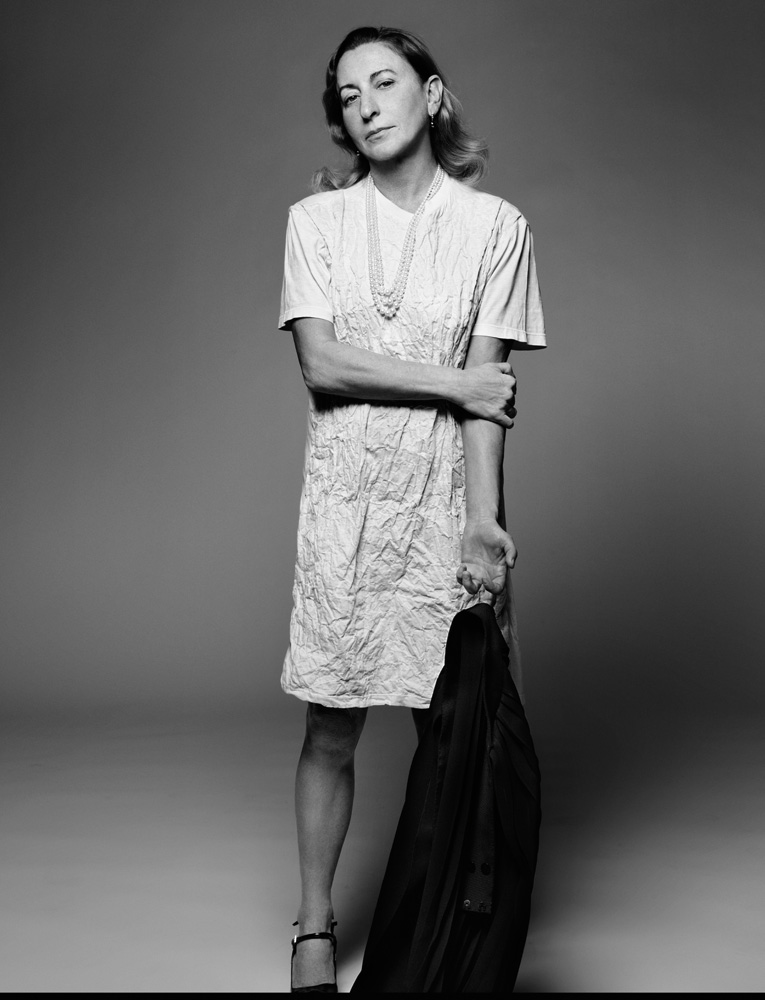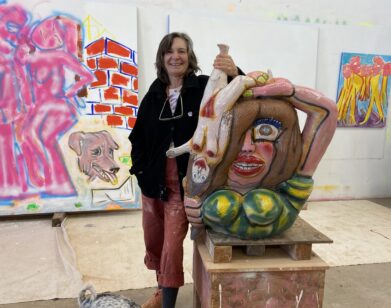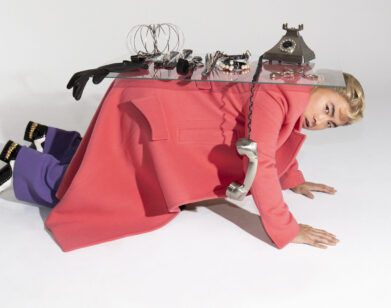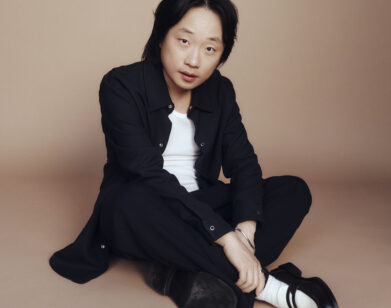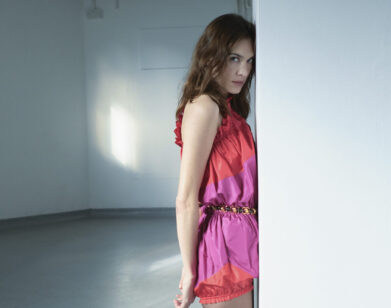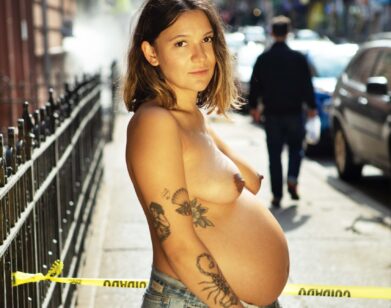Prada Transformer
Although many an artistic genius would argue that two heads are not always better than one, when those two heads happen to be Miuccia Prada and Rem Koolhaas, itâ??s safe to say that two heads can be better than 2 million. Prada and Koolhass are designers who blazed into the 21st century as the radical success stories of their fieldsâ??hers in fashion, his in architecture. But they are both virtuoso cross-disciplinarians as well. Theyâ??ve collaborated on a number of projects, starting with the Prada â??Epicenterâ? flagship store in SoHo, New York, that opened shortly after September 11 in 2001, all the way to current plans, unveiled in April of 2008, to build a permanent compound for the Prada Foundation south of Milanâ??the latter, in effect, turning Ms. Pradaâ??s 16-year-old arts organization into an enduring cultural institution. In the last decade, Ms. Prada herself has actively championed an unruly cross-hatch of talented young multimedia artists such as Tom Sachs, Mariko Mori, Carsten Höller, Nathalie Djurberg, and Francesco Vezzoli. Where so many top designers find their interests outside of fashion limited to the scope of Hollywood, Ms. Prada has shown how fashion can sit next to art, design, cinema, and architecture as a full partner.
In keeping with this history, Prada and Koolhaas are about to unleash what might possibly be their most ambitious joint project to date. In the last week of April, they open the Prada Transformer in Seoul, South Korea, a building that is, in reality, four entirely different structures housed inside the same tetrahedron shape. The Transformer promises to finally bring together all of the various disciplines that have engrossed Prada over the years: cinema, art, and fashion. Her long-traveling show â??Waist Down: Skirts by Miuccia Prada,â? will make an appearance here, as will ventures by enterprising Korean fashion students.
Learn more at prada-transformer.com
What has allowed Prada to combine these cultural genres into one hub isnâ??t Koolhaasâ??s ability to pack together a number of competing pavilions under one roof. Itâ??s that the roof itselfâ??along with the walls, the floor, and everything holding the building togetherâ??will actually rotate, flip, and transform. With the help of four cranes, the structure changes into four distinct shapes: a hexagon, a cross, a rectangle, and a circle. Each new façade operates as the setting for its own distinct cultural program. Prada is already planning a number of curations and special projects to fill these shape-shifting walls, moving Seoul culture in and Western culture out before the whole structure is packed up in September to be resettled anywhere else on the planet that the Foundation sees fit. When youâ??re Prada and Koolhaas, you really can have it all.
The two sat down with artist Francesco Vezzoli earlier this year for what is the first interview that the close collaborators and cultural masterminds have ever agreed to do together. The meeting took place a little more than a week before a fire in Beijing threatened another of Koolhaasâ??s highly regarded projects in Asiaâ??the mesmerizing titanium zinc alloy-clad CCTV headquarters. Thankfully, the structure survived. Here, Prada and Koolhaas weigh in on the value of transformational architecture, the death of celebrity culture, and why the next generation isnâ??t as cynical as most people think. FRANCESCO VEZZOLI: So letâ??s talk about the Transformer. When did this idea come up and when did you start working on it?
MIUCCIA PRADA: I think basically it came from the idea of doing activities in countries and places that were not Milan. Iâ??ve been doing things in Milan for many years. For a while I wanted to open a branch of the Fondazione in Beijing, and that took a long time just to search for a proper place. One recent example that did come to fruition is the Carsten Höller Double Club, also known as Prada Congo Club, which opened in London last November . . . Actually, I really donâ??t remember how exactly it started for our idea in South Korea. It was mainly because it is a place that is not a big capital and it has a very different culture.
REM KOOLHAAS: Do you know South Korea? Have you ever been to Seoul?
VEZZOLI: Unfortunately not.
KOOLHAAS: Itâ??s not that famous but it is a wonderful city, very lively. Itâ??s mountainous, like Switzerland, but also a metropolis, which is a very strange but exciting combination.
PRADA: The starting point was the idea of movement, something like mobile architecture. I donâ??t want to say temporary, because temporary is such a trendy word . . . I would say a series of activities in different places. We wanted to have a flexible space, something that could exist anywhere we think could be right for it.
KOOLHAAS: What was also important is that, for the first time, Prada gave up on the idea that all the activities should be separate . . .
PRADA: Yes, thatâ??s true.
KOOLHAAS: I think this was crucial. The Fondazione has been completely separate from the fashion house and this in a sense is an experiment which tries to give it autonomy, but at the same time uses a single tool to serve the purposes of two or three sides of Prada.
VEZZOLI: So in a sense it has a degree of . . .
PRADA: Challenge . . . risk.
KOOLHAAS: How would you describe the risk?
PRADA: The risk is that it could be interpreted as showing off, as a deliberate display of all of our activities. But it started with ideas that were all really good in principle. It was personally something I very much wanted. In the end, it was a really great way to confront different cultures.
VEZZOLI: Should we call it a pavilion? Is that the most accurate word for the Transformer site?
KOOLHAAS: Thatâ??s a word I both like and dislike . . . The most important aspect of the building is that itâ??s a provisional structure and it takes the ambiguity of the Prada position into account and also the inventory of things that Prada wants to avoid. They didnâ??t simply want a pavilion. In the beginning we had many versions that werepavilionlike, and somehow they were never satisfying. So we concentrated on four different purposes that Prada wanted the site used for, and for each one we designed a perfect, almost utopian, condition. Rather than having one average condition that met every possibility, we ended up conceiving a pavilion that, simply by rotating it, acquires a different character and accommodates different needs. It became a very precise tool, I would say, that creates an almost uncontrollable shape . . .
PRADA: [to Koolhass] It took a long time before you accepted to do it . . .
VEZZOLI: Why?
KOOLHAAS: Because there are so many pavilions around now and there are so many precedents, I almost always turn down these proposals.
PRADA: A pavilion can be a trendy concept, but we wanted a worthy building, good for all kinds of activities.
KOOLHAAS: The Japanese have pavilions; the Koreans already have pavilions as part of their own architecture . . . The relationship to the site isalso important. Itâ??s always in combination with something else around itâ??a temple, a park, a palace . . .
VEZZOLI: Having known Miuccia for a long time, I always felt that eventually there would be some project that would draw all of the different aspects of her work into one. For me, this project becomes more like that place of her mind, and your mind . . . As if you both were finally able to put together all of these previously unmergeable elements.
KOOLHAAS: Yes, the project is about merging the unmergeable.
VEZZOLI: The permanent space of the Fondazione in Milan, which you presented in April of 2008, seems an equally wild extension of this concept. You announced that there was going to be a part dedicated to fashion, a part dedicated to Luna Rossa and the three Americaâ??s Cup races Prada took part in, and, of course, all of the spaces for artistsâ?? installations.KOOLHAAS: Donâ??t forget what we did in New York, where we conceived a space that could be both fashion and public, fashion and art . . .
PRADA: Yes, in fact, Germano Celant [the director and curator of the Prada Foundation] told me last night that he thought our so-called Epicenter was the first step of this process, and that the Transformer is an extreme consequence of what we started.
VEZZOLI: I think the whole core of the project is that it is addressing the relationship between art and the means that support art.
PRADA: Exactly. It probably is the right moment, because weâ??ve been doing this for a long time.
VEZZOLI: What kind of activities have you already planned?
PRADA: Itâ??s a work in progress. For instance, we invited [filmmaker] Alejandro González Iñárritu to be there for one week and each night talk to people and present movies which are relevant for him.
KOOLHAAS: So is there also an Asian connection?
PRADA: I donâ??t know yet which movies he selected . . . Maybe there is a connection, maybe not. I think he likes the idea of doing it in a place like thatâ??a place thatâ??s not just a simple movie theater, but a space conceived precisely for that kind of projection and discussion.
VEZZOLI: Itâ??s not important if itâ??s in Seoul, basically . . . It seems to me more of a metaphorical place than a geographical one.
PRADA: Well, the fact that we ended up in Seoul actually is . . .
KOOLHAAS: . . . Part of the whole story. Seoul is a very vivid, authentic city, where there is even a form of resistance to the developing global condition, and that makes it especially exciting.
PRADA: I think it was chosen for being at the center of a geographical area . . . Itâ??s not Beijing or Shanghai or Tokyo, but itâ??s an important city with great activity. Take, for instance, the movies . . .
KOOLHAAS: And fashion and art . . .
VEZZOLI: Is the structure supposed to be moved or transferred to another city?
PRADA: Maybe to Milan. For the moment, itâ??s right for it to be there. I love the idea of a great director who comes from another part of the world going there to discuss his favorite movies . . . Itâ??s something I really love.
VEZZOLI: So, this issue of Interview is, in some ways, about the future. I was thinking of what the future means. I found this sentence by Eleanor Roosevelt: â??The future belongs to those who believe in the beauty of their dreams.â? [Prada and Koolhaas laugh]
KOOLHAAS: Itâ??s kind of sarcastic . . . Maybe not the beauty, but more the effectiveness . . .
PRADA: Another sentence, please.
VEZZOLI: Coco Chanel: â??A woman who doesnâ??t wear perfume has no future.â?
PRADA: This is tough . . .
KOOLHAAS: Do you have another quote?
VEZZOLI: Bernardo Bertolucci: â??I remember being young in the â??60s. We had a great sense of the future, a great big hope. This is what is missing in the youth today. This being able to dream and to change the world.â? Is this true? Or is Bertolucci out of touch with the young generation?
KOOLHAAS: Probably. When I look at my children, maybe they would not call them dreams, but I donâ??t think they are fundamentally different in terms of having fantasies about what they want to achieve and being ingenious and focused on those issues. I think Bertolucci is slightly too sentimental and nostalgic.
PRADA: I also completely disagree [with Bertolucci].
KOOLHAAS: I think the younger generations have had endless exposure to why they should not dream about the future. And part of that exposure is, of course, triggered by the generation of Bertolucci. So itâ??s a very crude situation, but I think that in spite of their efforts, there are now a lot of similar ambitions about creating a future.
PRADA: The younger generations have their own ideas, they have their own projects. When they talk, I am always surprised how much more lucid and cultivated they are and how they see things in a way that is much more complex than, for example, other generations did. But letâ??s stop this quotes game . . . I wanted to ask you, Francesco, what do you think about this combination of different fields?
VEZZOLI: As an artist, I am really enthusiastic about it. In my first three art videos, I had three divasâ??one from television, one from cinema, and one from the theater. I asked three famous movie directors to direct them. For each video, I collaborated with a different fashion designer . . . I mean, I am not afraid of contamination . . .
KOOLHAAS: Art contamination.
VEZZOLI: Thatâ??s what my work is about: contamination, and not being afraid.
PRADA: Itâ??s really interesting that you concentrated your research on the media. No other artist is doing that the way you do.
VEZZOLI: I believe, yes. That is mine.
KOOLHAAS: Do you mean in film?
VEZZOLI: No, I mean television and Internet, mainly. With their instant capability of reaching millions of people. If you think about history, Roman history for instance, there was already everything: powerful people, the rich, the poor, the greedy, corrupted politicians, lawyers, prostitutes . . . But the power of the mediaâ??and the consequent celebrity cultureâ??is something really new and specific about our time. I feel that that is the only real new thing of our age.PRADA: Itâ??s a very important point, itâ??s true. The power of the media is really the only new issue in the last 50 years, probably.
KOOLHAAS: Donâ??t you think that this situation will be deeply affected by the current economic crisis and this inescapable power of the media will be somehow weakened?
VEZZOLI: I see your point. But my impression is that, for the little I know about the crisis, there will certainly be less money . . . The movies will have smaller budgets, prices at art auctions will be smaller, but somehow the general audience will still want to buy InTouch and see the pictures of celebrities on the red carpet.
PRADA: That is also my impression.
VEZZOLI: Also, I think that gossip is a very cheap type of entertainment. Itâ??s very inexpensive.
KOOLHAAS: Iâ??ve just noticed in a very wide range of people in different countries a sort of annoyance and rejection towards that situation.
VEZZOLI: You seem to think that those type of celebrities will no longer hold all that capability of creating interest in themselves . . .
KOOLHAAS: The point is that everybody pretends that they are not creating interest and they all receive attention nevertheless, so this is the discrepancy: No interest, but attention. And that is not only true for celebrities, but for all of us.
VEZZOLI: I like the fact that you are predicting a future where celebrities will no longer hold this same attention. Can you imagine who could be their replacements?
KOOLHAAS: It could be much more drastic than we think. In other words, I donâ??t think it will be one kind of replacement with another categoryâ??I think the whole phenomenon . . .
VEZZOLI: Will just go down.
KOOLHAAS: Will change, yes. Have you ever been in Leninâ??s monument?
VEZZOLI: Not yet.
KOOLHAAS: The first time I went there it was 1969, middle of January, and there was a very long queue. It was very cold, 30 degrees, and many of the people in queue were brides and grooms, couples with little babies, entire families . . . Thatâ??s a celebrity!
VEZZOLI: Letâ??s go back to the Transformer. How is it going to be articulated?
KOOLHAAS: It will be designed to accommodate four different events: a cinema, a fashion show, an art exhibition, and the exhibition of the â??Waist Downâ? skirts exhibition, which will be a revised version of what has been touring since 2004. There will be also be Korean fashion students participating, so it is not only a show, but an engagement for all the four disciplines.
PRADA: Letâ??s talk about the structure and its conformation . . .
KOOLHAAS: Each section has its own footprint, and they are directly connected only at a few points. Architecturally, each of these footprints has a geometrical shape, but in order to combine them, you have these formless sections in between. So in that sense, itâ??s something that is both very formal and formless. Itâ??s also about the current moment in architecture, because most of it is a blob . . .
VEZZOLI: What does that mean?
KOOLHAAS: The blob is typically amorphous and, combined with the different footprints, this can be something in between. At some point we found a material that is used to wrap abandoned airplanes in the desert as a form of preservation. Itâ??s an elastic material you can simply wrap the entire structure with.
PRADA: I love the fact that the building changes accordingly to the needs.
VEZZOLI: So the actual building will have a membrane . . .
PRADA: Yes, itâ??s covered. Iâ??ll explain: We have four bases, one for each of the four different activities. For contemporary art, the base is cross-shaped; for the fashion show, the base is round; for the â??Waist Downâ? exhibition, the base is hexagonal; and the last one, for cinema, is rectangular. There will be cranes that turn it around every time we want to change activities . . .
VEZZOLI: It sounds fantastic.
KOOLHAAS: And this membrane takes light in a very peculiar way.
PRADA: Itâ??s almost milky.
KOOLHAAS: Yes, milky. But artificial light is going to have a big impact.
VEZZOLI: And there will be light inside . . .
PRADA: What makes this project so radical is this kind of ever-changing shape and form according to the requests. And, actually, he didnâ??t want to do it until he got this result. Probably he had the intuition of what we wanted to do and say. But this flexibility and changeability was crucial. The content could be done anyplace, but the real invention is the architecture. The architecture is the only work that really defines a new way of doing things. I think this point is fundamental.
VEZZOLI: How did you arrive at the idea of transportable architecture?
PRADA: When I wanted to do something in Beijing, I could never find a place. I always have this idea to create and display activities somewhere else around the world, but in fact itâ??s been very difficult since the start, as you have to find the right place that can represent, or could be as significant as, your ideals. It rarely happens, and thatâ??s why the Double Club was built from scratch. This project is built from scratch, too. When you want to do something that is challenging or interesting or new, you never find the place. All the places are obvious or old or generic. For example when we had to do that kind of party in April of 2007 at the market in Valencia [for the opening of the Louis Vuitton Cup elimination race] we had to transform it so much to make it interesting . . . And so you realize that the role of architecture is fundamental.
VEZZOLI: So you felt the need to make this project happen.
PRADA: Thatâ??s why I really pushed him to do it.
VEZZOLI: [to Koolhaas] Did she push you?
PRADA: Very much. I really pushed.
Francesco Vezzoli is a Milan-based artist.

